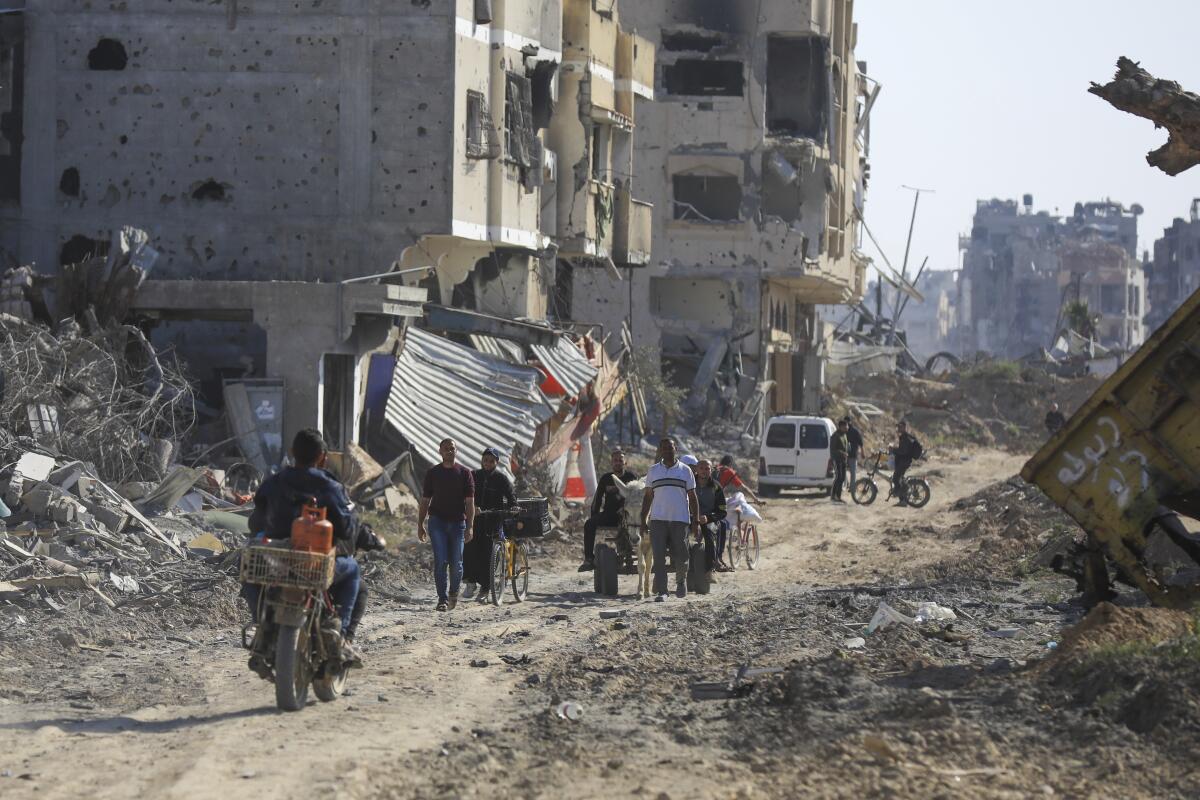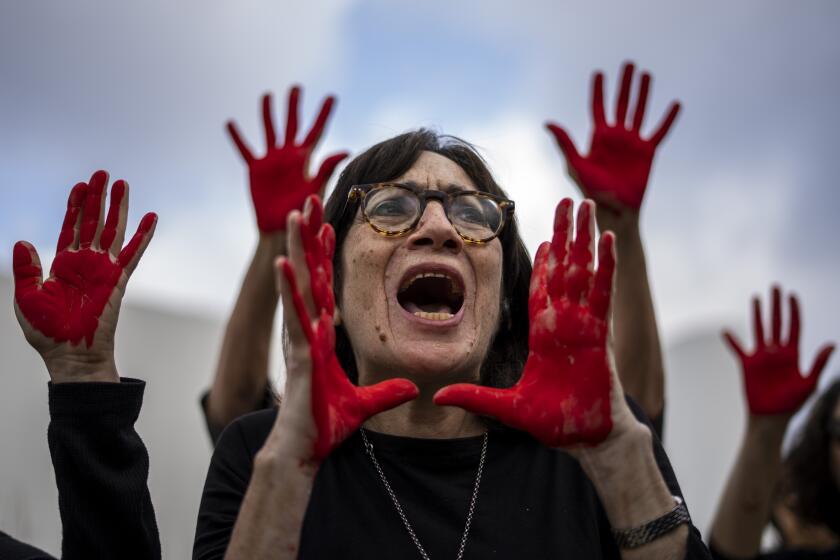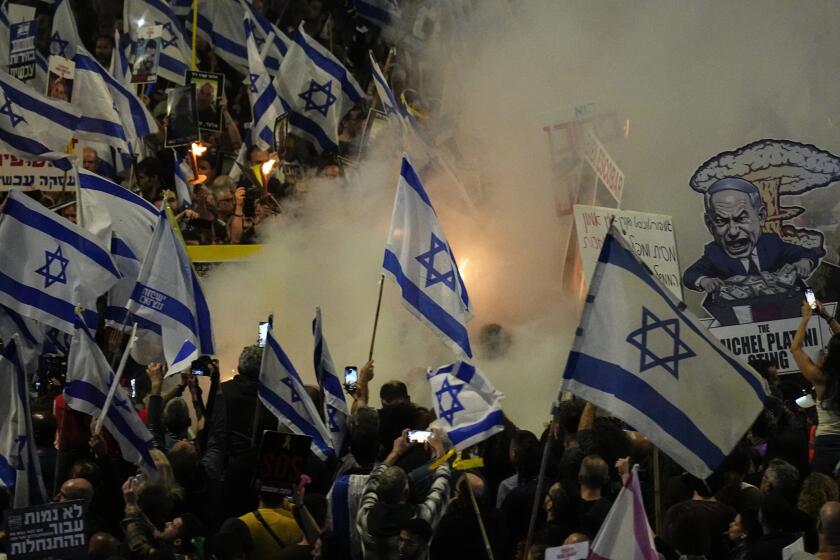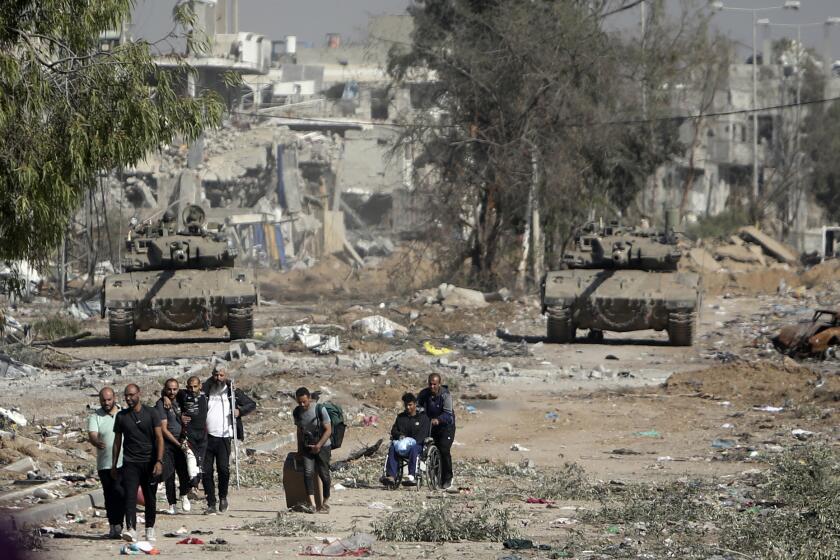After Israeli withdrawal, Palestinians returning to Khan Yunis find an unrecognizable city

- Share via
DEIR AL BALAH, Gaza Strip — Stunned Palestinians found their home city unrecognizable Monday as they filtered in to salvage what they could from the vast destruction left by Israeli troops who withdrew from southern Gaza’s Khan Yunis a day earlier after months of fighting and bombardment.
With thousands of buildings destroyed or damaged, families tried to find their homes along streets bulldozed down to the dirt, surrounded by landscapes of rubble and debris that were once blocks of apartments and businesses. On other blocks, buildings still stood but were gutted shells, scorched and full of holes, with partially shattered upper floors dangling precipitously.
The scenes in Khan Yunis underscored what has been one of the world’s most destructive and lethal military assaults in recent decades, leaving most of the Gaza Strip unlivable for its 2.3 million people. It also portended what is likely to happen in the tiny coastal territory’s southernmost town of Rafah, where half of Gaza’s uprooted population is now crowded, if Israel goes ahead with plans to invade it.
Israeli Prime Minister Benjamin Netanyahu escalated his pledge to take the offensive to Rafah, declaring in a video statement Monday, “It will happen. There is a date,” without elaborating. He spoke as Israeli negotiators were in Cairo discussing international efforts to broker a cease-fire deal with the militant group Hamas.
Magdy abu Sahrour was shocked at seeing his house in Khan Yunis flattened.
Israel’s military says it has withdrawn its forces from the southern Gaza city of Khan Yunis, wrapping up a key phase in its ground offensive.
“I couldn’t find my home because of all the destruction,” he said as he stood in front of the rubble. “Where is my place, where is my home? … It’s a tragic situation.”
Israel sent troops into Khan Yunis in December, part of its blistering ground offensive that came in response to Hamas’ Oct. 7 attack and hostage-taking in southern Israel.
The war, now in its seventh month, has killed more than 33,000 Palestinians, mostly women and children, according to Gaza health authorities. Israeli authorities say 1,200 people, mostly civilians, were killed and roughly 240 people taken hostage in the Oct. 7 attack.
Many of the thousands who came to Khan Yunis by foot and on donkey cart on Monday have been sheltering in Rafah. The withdrawal gave them a chance to see the wreckage of their homes and salvage a few possessions. But with the city now unlivable, they said they had little immediate chance of returning.
An estimated 55% of the buildings in the Khan Yunis area — around 45,000 buildings — have been destroyed or damaged, according to the latest figures from two researchers in the U.S. Corey Scher of City University of New York and Jamon Van Den Hoek of Oregon State University have been using satellite imagery to track destruction throughout the war.
“Where do I sleep? Where do I go?” Heba Sahloul’s aged mother sobbed in despair, sitting amid the rubble of what was left of the family’s living room. Her daughters searched for anything they could take with them. The room’s walls were blown away and the floor was piled with chunks of concrete, slabs of the ceiling and broken countertops. Only the columns painted pink gave any sign it had once been their home.
Israel’s military says it has recovered the body of a 47-year-old farmer who was held hostage in Gaza.
Sahloul said Israeli troops had ordered them to leave during the fighting. “We left all our things here, and we went out with only our clothes,” she said. Her father was killed earlier in the assault, leaving Sahloul, her sisters and her mother. “We are only six women at home and we do not know where to go or where to stay,” Sahloul said.
One woman clambered over slabs of collapsed concrete atop a mountain of wreckage that was once her home. Her son crawled on all fours into a hollow under the rubble and twisted rebar, clearing away concrete blocks.
“There are no words to describe the pain inside me,” the woman said, her voice breaking. “Our memories, our dreams, our childhood here, our family — we were raised with them here.… It’s all gone.” The woman, who identified herself only by her first name, Hanan, put a few items they found into a backpack, including a plastic red flower.
Khan Yunis’ main Nasser Hospital was trashed inside, with debris strewn around the wards and ceiling panels collapsed. The exterior appeared largely intact, but the extent of the damage was not immediately clear. Israeli troops stormed the facility during the offensive, saying they believed the remains of hostages were inside, though they did not report finding any.
Israel said that Khan Yunis was a major Hamas stronghold and that its operations there killed thousands of militants and inflicted heavy damage to a vast network of tunnels used by Hamas to move weapons and fighters. It also claimed to have found evidence that hostages were held in the city.
With the troops’ withdrawal, Hamas could seek to regroup there as it has in northern Gaza, where the military scaled back forces earlier.
When Israel declared war against Hamas, it stood unified at home. Now it is isolated amid global outrage over the rising death toll in the Gaza Strip.
Israel’s plans to invade Rafah, which it says is Hamas’ last major stronghold, have raised international alarm over the fate of the roughly 1.4 million Palestinians sheltering there, most displaced from other parts of the Gaza Strip. Israel’s top ally, the U.S., has said invading Rafah would be a mistake and has demanded to see a credible plan to protect civilians.
Israel is purchasing 40,000 tents to prepare for the evacuation of Rafah, an Israeli official said, speaking on condition of anonymity because they were not authorized to speak to the media. It was unclear where the tents would be set up or how many people they could house.
Allowing people to return to Khan Yunis could relieve some pressure on Rafah, but many have no homes to return to. The city also is likely filled with dangerous unexploded ordnance left by the fighting.
Israel’s military quietly drew down troops in devastated northern Gaza earlier in the war. But it has continued to carry out airstrikes and raids in areas where it says Hamas regrouped, including Gaza’s largest hospital, Shifa, leaving what the head of the World Health Organization called “an empty shell.” Israel blames Hamas for the damage, saying it fights from within civilian areas.
Israel says its war aims to destroy Hamas’ military and governing capabilities and return the roughly 130 remaining hostages, a quarter of whom Israel says are dead.
Negotiations mediated by Qatar, Egypt and the U.S. over a cease-fire and exchange of captives continue. But Israel and Hamas appear to remain far apart. In a statement Monday, Hamas said the latest response it has received from Israel does not include a permanent crease-fire or the withdrawal of Israeli forces from Gaza. It has repeatedly said both terms are not negotiable, while Israel has firmly rejected them.
Shurafa and Magdy write for the Associated Press. Magdy reported from Cairo.
More to Read
Sign up for Essential California
The most important California stories and recommendations in your inbox every morning.
You may occasionally receive promotional content from the Los Angeles Times.












